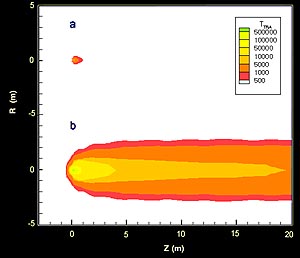|
Leonid MAC |
| home |
| View the shower |
| Mission Brief |
| Science Update |
| Media Brief |
| links |
LEONID DAILY NEWS: November 9, 2000
Figure left: the spectrum of a Leonid meteor in the red and near-infrared. Intensity is plotted versus wavelength.
NEW METEOR PICTURE
The bright light of a meteor originates in a warm wake, not in the meteor's hot head
as was thought before, according to a new spectroscopic study published in an upcoming
issue of Earth, Moon and Planets.
Spectroscopy is a powerful technique to identify chemical processes in the meteor path
and learn about physical conditions such as temperature. Spectroscopy turns white light
into its array of colors and measures the intensity of specific colors
that are emitted by atoms and molecules. Those colors are expressed in
terms of the wavelength of the light.
During the 1998 Leonid MAC, the emission of molecules created in the meteor plasma could be
measured for the first time in enough detail to derive the temperature and internal
excitation of the air plasma.
Peter Jenniskens and
Mike Wilson used a cooled un-intensified CCD camera with an objective grating to
measure the meteor's visible light intensity. The result is
shown as a blue line in the figure to the right. The wavelength scale corresponds to
colors ranging from a red-orange left to a deep red on the right.
The spectrum betrays the presence of oxygen atoms and a broad band caused by the molecule
nitrogen (N2) shortly after it is created by the recombination of nitrogen atoms (N).
The spectrum is so detailed that the measurement can be compared directly with models
of air plasmas. Christophe Laux and Denis Packan of Stanford University calculated
the expected emission spectra for two very similar temperatures. A temperature of
4,300 Kelvin (about 4,000 degrees Celsius), seems to match the data best (red line). Some bumps
near the point of the arrow are actually a residual signature of the recombination process,
not included in the calculations. A slightly higher temperature of 4,670 K (black line)
matches one of the oxygen lines better, a surprisingly small difference for what should
be highly non-equilibrium conditions.
Figure left shows the new meteor model by Iain Boyd. Figure right is a video
animation showing the growth of the wake.
4,300 K is a very low temperature, given that air molecules collide with the meteoroid
at an astonishing 160,000 miles per hour. To understand where this rather balmy temperature
originates, Iain Boyd of the University of Michigan calculated this model of the meteor.
For the first time,
he used Monte-Carlo type calculations, taking into account that the meteoroids are very
small and shocks are not typically formed.
The result paints a fascinating picture of a meteor. The light we are seeing is from a
warm wake, not from the meteoroid head. The cause: air is warmed by interaction with
an ablation vapor cloud in front of the meteoroid. Without evaporation of meteoric
matter (situation "a"), there is no wake and all light comes from the head of the meteor.
When ablation is included in the calculations (situation "b"), a wake results with just
about the right temperature to explain the observed spectrum.
The resulting picture of a meteor opens new pathways for organic molecules to survive
the plunge in the atmosphere. Moreover, the temperature of the wake turns out to be
just right for breaking up the C-O band in carbon monoxide, an important step in creating
potentially interesting atmospheric chemistry in Earth's early atmosphere
(Full paper -PDF).
Nov. 09 - New meteor picture Nov. 08 - Spin city Nov. 07 - Meteors affect atmospheric chemistry Nov. 06 - Listen to this! Nov. 04 - Fear of heights? Nov. 03 - The pale (infra-red) dot Nov. 02 - Twin showers Nov. 01 - Leonids approaching Earth Oct. 31 - Prospects for Moon Impact Studies Oct. 30 - Comet dust crumbled less fine
| ||




